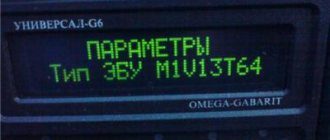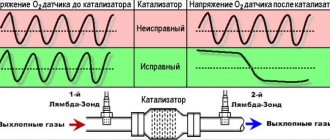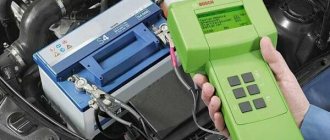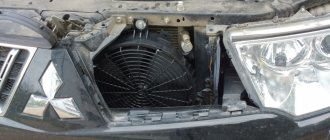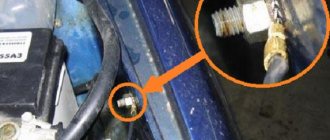I check with a multimeter on the battery and generator the charge is 13.7, and when connecting diagnostics it shows the on-board voltage 10.5. Sometimes it drops to 8. The car does not run smoothly, the speed jumps, and there are misfires. What could it be?
- Checking the battery charge from the generator in a VAZ 2110 – 5 answers
- The diode bridge of the VAZ 110 burned out - 4 answers
- Why does the generator produce low voltage, VAZ 2110? – 4 answers
- The generator failed in the VAZ 2110 - 3 answers
- Why does the voltage on board the VAZ 110 network increase - 3 answers
Maybe your multimeter is lying? But at a voltage of 10 volts there may be problems, check the generator in this case. But before using this multimeter, even if it’s lying, measure the voltage with the car not running, and then with the car running. If the difference with the engine running is a couple of volts higher than when the car is not running, then the generator is working and you need to look for the reason for the poor performance elsewhere.
You checked the generator and battery with a multimeter, this is the correct voltage, although it is close to the lower charging limit of the generator.
When diagnosing, you see on the computer the voltage that the engine controller shows. Well, since it differs from direct measurements on the battery and generator, it means your 13.7 volts simply do not reach the “brains”, that is, they are lost somewhere. Most likely, in some place the wire is shorted to ground (although of course in this case the fuse should burn out, but there are cases that the fuse can withstand a small load) or the wires are shorted together. There may be another case, the contacts are simply rusted or oxidized, let’s say the “ground” points, the resistance at such points increases, the current passes with difficulty, and so there is insufficient voltage. It is quite possible that it passes there in impulses, and this is the result - “the speed jumps and the ignition misfires.” Or alternatively: the contact on the ECU connecting block may have loosened. You can start checking there. The controller is located near the front passenger's left foot behind the plastic panel
Where did you do the diagnostics? A good auto electrician-diagnostician will usually tell you where to look for a fault. And a really good one will also find this malfunction and fix it (of course this will cost money).
If the generator stops charging, there is nothing good about it. It is necessary to immediately begin searching for the cause of such a malfunction. Otherwise, all your electrical equipment will be without power, and the battery will soon run out completely.
If the generator works well, then the battery will not need additional charging with special devices for many months, sometimes even years. The battery will consistently retain at least 60% charge. Thus, the batteries are constantly replenishing their charge reserve through the operation of the generator.
Appearance of the device
Consequences of low on-board voltage
If the voltage in the on-board network is low, the car continues to work somehow. For this reason, many car owners drive like this, at best, postponing the solution to the problem. Others never even think about what voltage there is in the on-board network of their own car. It goes - and it's good. Attention is drawn to this issue already when the consequences of low voltage begin to appear.
These include:
- Constant undercharging of the battery . If the voltage on board the car is generally below 14.4 V, the battery will never see 100 percent charge from the alternator in its life. In the best case, the charge level will float around 40-60%. And it will be fully charged only from a stationary charger.
- Lack of time to restore the battery . If you use the car for short and rare trips, the battery simply will not have time to return the energy spent on starting. This problem tends to accumulate. That is, after each trip the shortage will become greater and greater. As a result, the battery will eventually discharge to zero.
- Accelerated battery degradation . Car batteries last longer the more time they spend in a well-charged state. If deep discharges occur, the battery is generally charged less than 60% - its service life is reduced, if not by several times, then by a lot. Sometimes he doesn't walk for more than a year. It quickly loses capacity and inrush current.
- Lack of power for powerful consumers . The first thing people usually pay attention to is the head light. When the voltage is low, the headlights shine weaker than they should. The radio (with the subwoofer is absolutely terrible), the inverter, and the air conditioner suffer from this problem.
- Unstable engine operation . Namely, floating idle speeds, misfires, sudden stops. Actually, there may also be problems with starting the engine, since a weakly charged battery does not turn the starter well.
- Failure of electronic elements . Happens extremely rarely. But it happens. Especially if the voltage drops in the on-board network reach critical values.
In most cases, the cause of low on-board voltage not found in a timely manner tends to progress. That is, at first there seem to be no problems. But over time they accumulate and become more noticeable. In the end, if you don’t do anything, one day the car will become a stake. And it’s also good if it’s in a garage, and not somewhere on a deserted highway.
The generator does not provide charging and voltage VAZ-2114: reasons, repair
Sooner or later, the VAZ-2114 generator will stop providing the necessary charging, which will create a lot of troubles and problems. It’s just that at one point the car may not start because this unit has not properly charged the battery. This article tells you how to find and fix a problem in the form of incomplete charging of the generator.
about the reasons for the lack of charging on the battery
The material will tell you how to disassemble and repair a car generator, and also talks about some of the subtleties and nuances.
Generator device
Generator removed from a VAZ-2114 (original) Generator from a VAZ-2114 with the cover removed, the diode bridge is visible
Before identifying generator malfunctions, it is necessary to have some understanding of its design and structure. So, let's look at what main parts it consists of.
On models of the VAZ 2113-2114-2115 family, a generator marked 37.3701 is installed.
VAZ generator device
Generator 37.
3701: 1 – cover on the side of the slip rings; 2 – rectifier block; 3 – rectifier block valve; 4 – screw for fastening the rectifier unit; 5 – contact ring; 6 – rear ball bearing; 7 – capacitor; 8 – rotor shaft; 9 – output “30” of the generator; 10 – output “61” of the generator; 11 – voltage regulator; 12 – terminal “B” of the voltage regulator; 13 – brush; 14 – stud securing the generator to the tension bar; 15 – pulley with fan; 16 – rotor pole piece; 17 – spacer sleeve; 18 – front ball bearing; 19 – drive side cover; 20 – rotor winding; 21 – stator; 22 – stator winding; 23 – rotor pole piece; 24 – buffer sleeve; 25 – bushing; 26 – clamping sleeve
Now, let's look at the design of the generator in a disassembled state.
Generator disassembly diagram
Generator parts 37.
3701: 1 – capacitor; 2 – voltage regulator assembled with brush holder; 3 – terminal block for additional diodes; 4 – insulating bushings; 5 – rectifier block; 6 – contact bolt; 7 – stator; 8 – rotor; 9 – spacer sleeve; 10 – inner bearing mounting washer; 11 – drive side cover; 12 – pulley; 13 – outer bearing mounting washer; 14 – coupling bolt; 15 – front rotor ball bearing; 16 – bushing; 17 – cover from the side of the slip rings; 18 – buffer sleeve; 19 – clamping sleeve.
Why the generator does not charge (main reasons)
If the generator has stopped providing a proper charge to the battery, as well as in the on-board network, the voltage drops when the engines are running, there are only two reasons for this. Let's look at which ones exactly.
Device overload
Additional equipment draws energy. This is what generator overload looks like
This effect is often caused by connecting additional lighting and other devices with high energy requirements. In this case, the factory generator cannot cope with its task and begins to lose efficiency, and ultimately may fail.
Battery and alternator mismatch
Battery and alternator mismatch
When installing additional equipment, many car enthusiasts make an irreparable mistake and install a larger power battery on their “iron horse”, without increasing the power of the generator. Failure of power characteristics between nodes leads to the fact that the generator cannot provide proper charging of the battery, which subsequently reduces the performance of the first one.
troubleshooting
To find the problem you will have to delve into the electrical part of the car. There is nothing complicated here, but you will have to work hard and learn some design features of auto electrics. Let's look at what causes poor charging and what you should pay special attention to:
- Weak contact connections.
- Breaks in part of the winding.
- Short circuit on the rotor.
- Mechanical failures.
- Stator short circuit.
What to do if there is no required voltage (solution methods for VAZ-2114)
Basically, the methods for solving the problem are banal - replacing the generator. But, due to the high cost of the part, most motorists try to repair the unit. So, let's consider possible solutions to the problem of incomplete charging or lack of charging from the generator.
Weak contact connections
Damage to the contact group leads to charging problems
If the contacts are loose, this may be due to contamination or corrosion. To eliminate problems, you need to clean them with a sharp object or a special solution. Copper paste is suitable for lubricating and protecting external contacts . The internal contact connection is quite difficult to protect, so they are simply cleaned and installed in the seat.
THIS IS INTERESTING: Repairing a spoiler on a VAZ 2114
Breaks in part of the winding
Measurement to detect problems with the winding
Breaks in the winding are usually treated by replacing the winding. As practice shows, it is not cost-effective to rewind this unit, so motorists are looking for an alternative, which is a supported part.
Short circuit on the rotor
Diagnostic operations on the rotor
A short circuit in the on-board network that ends on the rotor can be treated by replacing the faulty part, but most motorists still agree that the generator will have to be replaced.
Mechanical breakdowns
Generator shaft deformation is one of the mechanical failures
Mechanical failure usually cannot be repaired and the damaged part is replaced with a new one. This is considered the most optimal solution to the issue. In terms of price, it may seem a little expensive, but cheaper than replacing the entire generator.
Stator short circuit
Diagnostic operations for rotor performance
Stator short circuit can also be treated by replacing the part or installing a new generator on the car. This is necessary so that the effect does not recur and the stator does not have to be changed again. When choosing a new spare part, we recommend that you familiarize yourself with the material: “difficulties in selecting a generator for a VAZ-2114.”
conclusions
Finding and eliminating the reasons why the generator on a VAZ-2114 has stopped charging is not as easy as it seems at first glance, but it’s still possible to do it yourself. Not every motorist can fix problems on their own, so it is recommended to contact a car service that can fix the problems.
Source: https://carfrance.ru/generator-ne-daet-zaryadku-vaz-2114-prichiny/
Normal voltage of the machine's on-board network
A few words about what the normal voltage of a car’s on-board network is, since opinions often differ. For some, 14.0 V is okay. Others have 14.8 V on board, and this is not enough for them. The reason for such a significant scatter most often lies in the incorrect interpretation of the instructions for charging the battery. There is especially a lot of controversy in the case of calcium batteries. Also in this matter, it is necessary to take into account the natural voltage drops that occur as the load on the on-board network increases.
Everything said below is based on the following “postulates”:
- The reference (normal) voltage of the on-board network of a passenger car is 14.4 V.
- With the load turned on, a drawdown is allowed, but not lower than 14.1 V.
- When using calcium batteries, a voltage of 14.7 V is allowed.
- The reference voltage without the load on should be observed at any engine speed, including at idle (but not lower than the minimum).
That is, if you started the engine and turned off all consumers, the ideal voltage of the on-board network should be considered 14.4 V. If in your case it is noticeably lower, the following are the most common 10 reasons that you should start looking for. If this does not help, then it is most likely advisable to contact a professional auto electrician. The dog is buried too deep.
Weak charging VAZ 2110 – Car
The electrical circuit of the car includes such a device as the voltage regulator of the VAZ 2110 generator.
Its task is to limit the output voltage of the generator and bring it to optimal values in accordance with the parameters of the on-board equipment.
In this article we will tell you how this device works, what malfunctions are typical for it, how to check and replace. We will also give you detailed recommendations that will allow you to continue driving with a faulty regulator.
What is a generator voltage regulator?
The voltage regulator is a relay that closes and opens the electrical circuit at the right times. In cars, this relay works to limit the output voltage.
The fact is that a generator with a certain rotor speed can produce a specific voltage. Since the rotor speed constantly depends on the crankshaft speed, the voltage changes accordingly.
To maintain a given voltage, a special device was developed that helps create an output voltage within the range of 12 - 14 Volts.
The first voltage relay was made in the form of an electromagnet, which opened with a change in the input value, and closed again when the voltage dropped, thus, the voltage in the electrical circuit of the on-board system was kept within a strictly specified range. This range is necessary for the correct operation of electrical devices. If you increase the voltage to values exceeding the nominal values, the device will simply fail.
Another stage in the development of mechanical relays was the emergence of a semiconductor device, which works much more accurately and reliably. A semiconductor relay has smaller dimensions and a special indicator that indicates whether the device is working or has failed.
The main difference between a mechanical relay and a semiconductor relay is the ability to make adjustments. If the output voltage of the supply circuit has changed, then by changing the position of a special device, you can set new values that will allow the relay to operate for a long time.
If the regulator relay fails, it must only be replaced!!!
Malfunctions and checking regulators on a VAZ
During operation, the voltage regulator may fail. In VAZ 2110 cars of all editions, a semiconductor relay is used, which contains graphite generator brushes. A relay malfunction can lead to the following consequences:
- Failure of all vehicle network devices. Usually, the first thing that happens is that all the lamps in the lighting devices burn out. If this suddenly happened, the relay has failed because the output voltage exceeded the rated values.
- Recharging the battery . Overcharging a galvanic cell is also unacceptable. This can lead to boiling of the electrolyte and subsequent damage to the battery.
- Small charge . As many car enthusiasts say, “undercharging” occurs. A weak battery will not be able to fully ensure reliable engine starting.
THIS IS INTERESTING: Daewoo Nexia front wheel bearing replacement
In total, there are only two malfunctions of the voltage regulator relay.
These are: failure of the relay (charging does not occur, or the battery is overcharged) and its incorrect operation (the relay works, but passes too little voltage, which is not enough to charge the battery). All relay malfunctions can be identified by many external signs, as well as through diagnostics.
The most reliable way to check the voltage regulator is to measure the electrical value at the battery terminals with the engine running and idling. The normal voltage is considered to be between 13.5 and 14.2 Volts. If the voltage level exceeds these values or is lower, it means that the voltage regulator is faulty and must be replaced.
In addition, there are other signs of a relay failure, after which the device usually begins to be checked:
- The charging indicator light came on while the engine was running. As the speed increases, the lamp goes out.
- Dim headlights when the engine is running. Likewise, as the speed increases, a brighter glow can be observed.
- Too bright headlights and subsequent burnout of the lamps also indicate incorrect operation of the relay.
- If the battery charge is sufficient for a small number of starts, it means that the relay does not fully provide the required charge.
What to do if the voltage relay fails?
It happens that the relay fails at the most inopportune moment, when you still have a drive home and the battery is not charging.
The battery capacity in economical mode can ensure fairly long engine operation, which will allow you to get to the repair site without any problems.
Below we will provide a list of recommendations that will help you drive, as they call it, “on battery power” and not stall.
- If the battery is overcharged, the relay must be disconnected from the circuit. To do this, the contact wires are removed from it and left hanging. In the case of the “ten”, it is enough to unplug the plug with the wire from the generator brush connector. Thus, battery charging is turned off, and further movement will no longer harm the battery.
- Many experts suggest going the other way - turning off the generator excitation winding . To do this, remove the corresponding fuse. However, this can be done if you know where the fuse is located.
- If the battery is weakly charged, then there is practically no reason to panic. To get to your destination, you need to maintain high speeds in order to, at least a little, bring the voltage value to the nominal value. to maintain the speed at 3000 rpm for a few seconds using the gas pedal This will prepare the battery for the next start.
- Avoid using music, power windows, headlights (especially high beams), and other electrical devices unless their use is absolutely necessary. This will save battery power well.
Reason #1. Erroneous measurements
First of all, you need to understand that the normal voltage of the on-board network must be “looked for” directly at the battery terminals. Not in the salon. Not in the cigarette lighter socket. Not anywhere else. Only on battery terminals. Therefore, if you rely on the readings of a standard or self-installed voltmeter, check its readings with the voltage at the terminals.
The second important point is the multimeter. It must be calibrated and show real voltage. As a rule, many modern multimeters are tested and adjusted in production. But not all. But almost any device can be calibrated independently. As a last resort, check what it shows with some standard. As an example, you can contact an electronics repair shop. They always have a normal laboratory power supply and calibrated meters.
The last important point is the current load on the on-board network. This has already been discussed above. The reference voltage of the vehicle's on-board network should be measured with the consumers turned off. The issue of voltage drop under load is another topic. Here we consider exclusively low voltage under all the above conditions.
Messages 17
1 Topic by alex-rzvk 2017-02-07 21:48:49
- alex-rzvk
- New member
- Inactive
- Registration: 2017-02-07
- Messages: 7 Thanks : 4
- Car: VAZ 2110
Topic: Resolved: Battery is not charging, voltage is 12.5 instead of 14 V
Good evening! Arriving at my relatives in the village and having skidded quite a bit in the snow, I sat down the battery. because I didn’t have a charger on hand, so after letting it sit for 2 hours in a warm place, the car started up. Halfway down the road, with the heater, low beam, fog lights and music on, suddenly the instrument lighting went out and the music stopped. Having turned off everything except the stove, I reached the house and took the battery to charge. Within a day the charge was zero. Deciding that the battery was completely dead, I bought a new one, and in addition bought a multimeter. I installed it, started the car, measured the voltage - 12.5, when normal, I subtracted 14-14.5. Well, I think the generator has failed, I removed the terminal from the battery, it works, although the speed itself raised to 2 thousand, the ominous “check” lamp came on on the tidy. I threw off the stamps, called back a couple of times, the “check” still didn’t disappear. Tell me, has anyone encountered this problem? p/s The battery charge indicator lamp lights up when you turn the key, but goes out after the start.
2 Reply from krasnopolskaya.y 2017-02-07 21:55:25
- krasnopolskaya.y
- Experienced
- Inactive
- From: Kletnya village
- Registration: 2016-02-29
- Messages: 276 Thanks : 85
- Auto: 2112
Re: Resolved: Battery is not charging, voltage is 12.5 instead of 14 V
poor generator to engine ground. Measure the voltage at the generator itself.
3 Reply from alex-rzvk 2017-02-07 22:09:24
- alex-rzvk
- New member
- Inactive
- Registration: 2017-02-07
- Messages: 7 Thanks : 4
- Car: VAZ 2110
Re: Resolved: Battery is not charging, voltage is 12.5 instead of 14 V
Maybe the voltage regulator has failed? When the battery was dead, when I tried to start it, the sound was as if the relay was shorting (I thought it was a retractor) and the alarm was blinking, as happens when you just picked up a brand
4 Reply from Patroclus 2017-02-08 07:26:31
- Patroclus
- Connoisseur
- Inactive
- From: RUSSIA
- Registration: 2014-07-05
- Messages: 637 Thanks : 104
- Car: Lada Priora 2171 Wagon: VESTA
Re: Resolved: Battery is not charging, voltage is 12.5 instead of 14 V
Maybe the voltage regulator has failed? When the battery was dead, when I tried to start it, the sound was as if the relay was shorting (I thought it was a retractor) and the alarm was blinking, as happens when you just picked up a brand
The voltage has dropped, and that’s all the “clacking” sounds. The check will go out over time due to a power supply error. Well, from the beginning, the belt is normal, it was slipping, maybe there was some snow and that’s why it weakened??
Reason #2. Battery is very discharged
A fairly common reason for low on-board voltage is the current battery charge level. If it is low, then the on-board network voltage may also be slightly underestimated. This happens because the discharged battery, after starting the engine, begins to charge intensively, consuming a large current. That is, it is a serious load on the generator.
To broaden your horizons on the topic of batteries, read the articles “Checking the battery with a load fork” and “Car battery voltage” on the Auto without service station website.
Life story . One good friend of the author once decided to overcome the low voltage of the on-board network using a well-known homemade method. We are talking about a diode that is soldered into the gap between the battery and the relay regulator. This solution allows you to “deceive” the relay regulator. The diode drops about 0.5-0.7 V, the regulator “detects” this and “demands” more from the generator.
Before installing the diode, the voltage in the car’s on-board network was 13.7 V. After - 14.3 V. Almost standard. But the author’s friend did not take into account one point, namely the current battery charge level. Since the on-board voltage was too low, the battery was constantly undercharged. The situation was further aggravated by the fact that the car was used for short trips.
The installation of the diode coincided with a case when it was necessary to drive a car over a fairly long distance. During this trip, the battery was charged normally, and the on-board voltage went up. It crept up to 14.8 V. And this is the voltage at which the battery boils (not every battery). As a result, as this experience showed, a diode was not suitable as a solution to the low voltage problem in this particular case.
But replacing the relay regulator helped.
Troubleshooting
Lack of charging can be caused by a wide range of reasons, which we will talk about today.
These reasons include:
- Weak contacts;
- Winding breaks;
- Short circuit on the rotor housing;
- Interturn short circuits;
- Mechanical breakdowns;
- Closing the positive clamp on the body;
- Short circuit in the phase winding;
- Short circuit of the stator to the housing.
Let's look at these situations in more detail to determine the true cause of the breakdown specifically in your case.
Start by turning off all additional equipment in your car that is not included as standard - DVR, navigator, audio system, etc.
Next, we perform the following operations.
- Measure the current output when the vehicle is cold, not running and all life support systems are disconnected. If there is no return at all, that's good. But this rarely happens. Almost always on tens there may be insufficient contact, some kind of short circuit, due to which there is recoil, but it is small. It’s much worse if the recoil is impressive and leads to battery discharge in one night spent in a parking lot or garage.
- If everything is normal, there are no strong current leaks or they are insignificant, and the battery has retained its charge, then you can return all the devices to the places that were installed additionally.
- Recheck the recoil. If at the same time the instruments show an active leak, then the reason does not lie in the battery and is not related to the generator. The culprit of the problem is one of the additionally connected devices.
- If no recoil is observed, then you need to carefully inspect the generator.
- There are many sources of trouble that can lead to generator failure. These include:
- Insufficient contact between the rotor rings and brushes;
- There was a break in the excitation winding;
- An interturn short circuit has occurred on the field winding coil. In this case, the generator will hum and get very hot;
- The field winding closes to the rotor housing;
- The stator shorts to the housing;
- A break occurs in the stator phase winding;
- The diodes have broken through in the rectifier block, that is, the diode bridge;
- The plus is shorted on the body;
- Mechanical problems have occurred.
Next, we will take a closer look at each of the reasons presented above.
Disassembled unit
Problem solving
- Poor contact. Loose contact can occur due to contamination, oil getting on the brushes, slip rings. Also, contact may deteriorate due to shrinkage of the springs that press on the brushes, or the brushes are stuck. Such phenomena lead to an increase in excitation resistance and can sometimes break the circuit. To eliminate the problem, sometimes it is enough to simply treat the surfaces with a rag soaked in gasoline. If the brushes are worn out, it is better to replace them. At the same time, check the condition of the springs and rings. The rings oxidize, so treat them with glass sandpaper.
- The winding has broken. If this happens, the battery will no longer charge. To determine the problem, place your hand on the battery. If there is a break, the device will begin to heat up. If you want a more accurate check, then disconnect the end of the field winding from the brush and connect the battery wires to it and terminal Ш using a voltmeter or a light bulb. If there is a break, the lamp will not light up and the voltmeter needle will not budge. Test each coil individually to determine which one is preventing the alternator from working. The internal coils must be replaced, and the internal coils must be soldered.
Unit diagram
- Short circuit between turns. An interturn short circuit can occur in any field winding coil. If such a situation occurs, the winding will begin to heat up, and the excitation current will increase. To check, be sure to measure the resistance of each coil. For this you will need a voltmeter.
Reason #3. Malfunction of the voltage regulator relay
The task of the relay regulator is to monitor the voltage in the on-board network, and as it changes, adjust the degree of excitation of the generator. That is, the voltage in the network drops - the relay-regulator “forces” the generator to produce more volts, and vice versa. If this part is faulty, then there is (more often) low voltage in the on-board network. This reason can be determined by a simple check of the relay regulator. The solution is to replace it.
The relay regulator fails for various reasons. Most often due to overheating. Less often, electronic components responsible for the correct operation of the circuit burn out. There are also low-quality models that work great at first, but then the voltage starts to float again. Original (but expensive) ones, as a rule, immediately and for a long time help solve the problem of low voltage.
What malfunctions can occur in the generator?
What could be the problem with the generator when, when you turn on the ignition, the light flashes or does not turn on at all and the control devices do not function? You should check to see if the fuse located in the mounting block is ok. If there is a break in the power supply, the following may occur:
- the “O” wire with the wires from the mounting block to the devices is broken;
- there was a breakdown of the “GP” wire with the wires from the ignition switch to this unit.
When the switch does not work due to breakdowns, it is enough to replace only the contact part that has become unusable.
If the battery is discharged, the generator voltage will not give the desired figure.
And the reason may lie in the fact that the control lamp has burned out, or perhaps the socket contacts are not pressed sufficiently against the printed circuit board. In this case, the lamp or faulty contacts are replaced.
You should look to see if there is an open circuit in the circuit connecting plug “D” of the generator and the devices. If this is exactly the case, then you need to look at the “KB” connections.
A lot also depends on the brushes if the VAZ 2110 generator does not produce the required power. They can wear out, freeze, the contact rings can oxidize, then you need to replace the entire brush holder along with the brushes. Oxidized parts are wiped with gasoline.
The terminals of the generator winding may become unsoldered from the slip rings, which need to be soldered or the surface of the generator rotor should be leveled.
A short circuit may occur in the valves, and the rectifier will have to be replaced. If the generator is noisy, it means there is a breakdown - the bearings are damaged; If the generator makes too much noise, you need to check the stator.
But when the generator 2110 does not produce 14.2 V, as it should, you need to start the engine - let it run for a while. In a few minutes, pressing the gas pedal, you need to increase the crankshaft speed to 3000 rpm. Now all functions should work, after which the voltage at the battery terminal is measured.
The voltage at this moment should be greater than 13 V. Other numbers indicate that there is a breakdown in the winding, or a short circuit may have occurred. You also need to check the voltage regulator with brushes; Maybe the reason lies in the oxidation of the generator winding rings.
The voltage regulator is checked by turning off all functions, but leaving the high beams on. Now you need to measure the voltage again, observing what it is now. Your mood will improve if the device shows the numbers 13.2-14.7 V.
The generator may be undercharged if the pulley is just spinning, and under heavy loads it begins to spin.
The normal output at idle is 14.2 V. Use a multimeter to take a measurement, but before that you need to check the input and output. Experienced craftsmen advise taking a welding cable, attaching the minus to the motor, and bringing the plus to the generator. If the result is negative, the generator needs to be changed.
Constant undercharging of the battery or its absolute discharge at the most inopportune moment is a headache for many car owners. One source of these problems may be the generator. But how to check it? Perhaps it's not his fault at all? Let's figure out together how much the generator must produce for the normal functioning of all car systems and maintaining the battery in a charged state.
Reason #4. Insufficient generator power
The first point is the natural wear and tear of the generator. If it reaches a critical level, then the power it produces is simply not enough to power all consumers.
The second point is the increased load on the generator. If you have installed a powerful subwoofer, inverter, xenon light, or refrigerator in your car, there is every chance that the generator will not be able to handle this burden. The problem can be solved very simply. Replacing the generator with a more powerful one. And you don’t have to worry about the myths that this will cause the battery to deteriorate, the engine to somehow suffer, and so on.
Reasons for low charge output
There are two reasons why the VAZ-2110 generator produces a low charge:
- Mismatch between the battery and the car's generator.
- Overload.
For the first reason, the generator may produce little charge due to the fact that owners of VAZ-2110 cars install additional electrical equipment. To do this, they also purchase and install a much more powerful battery. In this case, the generator does not have enough resource.
The second reason suggests that motorists overload the VAZ-2110 generator with various video devices, various speakers, electric pumps, etc. Additional devices greatly reduce the charge.
It is worth paying attention to how much it is necessary to supply to the VAZ generator for normal operation of the entire mechanism. This norm always depends on the technical condition of the car itself as a whole:
- if the car has driven a long enough distance, the generator can produce a voltage of 14.0-14.2 V;
- if the car is parked and has a cold engine, the charge will be 14.2-14.4 V.
Also, a lot of reasons can be attributed to the low charge of the VAZ-2110 generator. These can include such as wire breaks in the winding, weak contacts, and stator short circuit. The closure of the rotor housing and the interturns also affect the small charge. Mechanical problems with the generator affect the decline in performance.
In order to finally make sure that the VAZ-2110 generator cannot produce the required charge, it is necessary to find the final reason. First of all, you must disable all installed additional equipment that is not included in the complete vehicle package. This includes a navigator, audio speakers, video recorder, etc. Next, it is important to measure the return current output when the engine is cold, remembering to turn off the entire life support system of the car. It's good if there is no return. If this occurs, the battery will discharge very quickly. After performing a repeated drive, you will finally be convinced that there are no problems in the battery, and it is not the reason for the VAZ-2110 generator to issue a low charge. All removed devices can be reinstalled.
The next step in checking that the generator is not capable of delivering a charge is to check the power delivery mechanism itself. The reason may be quite serious. This is both insufficient contact of the brushes with the rings and a break in the wires in the winding. The generator can heat up and hum due to the short circuit of the excitation coil, or a phase failure of the stator winding. It is also capable of delivering a bad charge (small) due to mechanical deviations.
Reason #5. Alternator belt slippage
It's simple - the generator generates electricity in the required volume as long as it spins. If it is driven by a belt that is worn out, torn, stretched, or slips, the low voltage of the on-board network will not be long in coming. Often the belt slips for no apparent reason. That is, it is intact or even new, and correctly tensioned. In such cases, the cause may be water from puddles that has gotten onto the generator pulley, or motor oil flowing from all the cracks from the engines of old cars.
Reason #6. Burnt out diode bridge
The task of the diode bridge is to rectify the alternating voltage produced by the car's generator. It consists of at least six diodes connected in a bridge circuit. If at least one of the bridge diodes burns out (breaks through), the on-board network voltage drops. A very simple check of the diode bridge allows you to identify the problem. The solution is to replace burnt out (broken) diodes or the entire “horseshoe” at once.
Reason #7. Car wiring problems
There are 3 problems with wiring that can cause low voltage on the on-board network:
- Short circuit.
- Break.
- Poor contact.
Searching for all this is not so easy, and it is impossible to describe the process in a nutshell. Either we study the topic more deeply, or we go to an auto electrician. Perhaps you will be “lucky” and one of the above problems will appear somewhere on the surface, where you yourself will be able to identify it and eliminate it on your own.
Reason #8. Unreliable contact in the battery charging circuit
The first point to check is the battery terminals. If there is poor contact here, the on-board network voltage will definitely be floating. The problem is solved simply. The battery terminals are cleaned of oxides and salts, and the clamps are checked for integrity and securely tightened. For prevention, it is advisable to protect these points with some kind of compound that prevents the deposition of oxides and salts on the terminals and clamps.
Even if the battery terminals look clean on the outside, do not be lazy to remove the clamps and check the contact points in more detail. Over time, a deposit forms between the clamps and terminals, due to which the voltage of the on-board network may decrease. It is recommended to visit here at least twice a year.
The second point is the engine mass. As a rule, this is a thick wire that goes from the negative of the battery somewhere to the lower part of the engine. The conditions there, to put it mildly, are not the best. The contact area quickly oxidizes, rusts, and becomes dirty. Checking the engine weight is very simple (you can do it with the engine off). To do this, first measure the voltage at the battery terminals. Then leave the positive probe on the battery, and touch the negative probe to the motor near the generator. If there is a difference between the indicators, the ground wire needs revision.
Connection diagram for the VAZ-2110 generator
Connecting a generator to a VAZ 2110 car is not difficult. All you need is some wrenches and patience. First you need to determine which side the mechanism is installed on. Everything is simple here. You just have to look at the fastenings and location of the rollers. After this, you should place the device on the seat.
The next step is to connect the positive and negative wires. The positive wire is usually red and thick. The negative one is slightly smaller, black or brown. The wires must be placed in their places on the generator and tightly clamped with nuts. Make sure that the wires are securely and firmly fixed. This determines how well the electricity will flow from it. After this, you can fix the device in its seat using bolts. Next, we put on the belt and start the car to check its performance.
If there is no charging, then you should proceed to detailed diagnostics of the device. First, let's look at the VAZ 2110 charging circuit diagram. Electrical connection diagram for the generator on a VAZ 2110, VAZ 2111, VAZ 2112 car:
Reason #9. Insufficient cross-section of wires in the battery charging circuit
Occurs after serious and inept repair of car wiring. Insufficient cross-section of wires in the generator-battery circuit is a guarantee of low voltage on the on-board network. In addition, even “native” power wires can have a small cross-section. Over time, the veins gradually break at the bends and at the attachment points, as a result of which the resistance of the chain section increases. Repairing both the first and the second is elementary.
